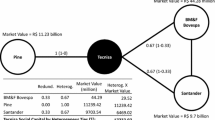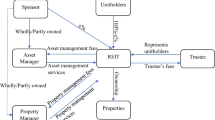Abstract
This paper uses biographical information of executives and directors of REITs in the US to show whether, and through what channels, top executives of REITs are influenced by their social peers when determining capital structure risk control strategies, especially in critical periods. Our focus is on the period of the 2007–2009 Financial Crisis. We find that peer influence through past employment and sharing activities significantly facilitate peer learning in making decisions on debt maturity extension, but does not affect leverage reduction. We find that being educated from the same school carries some effects on leverage reduction, possibly via its influence on managers’ personal traits. However, concurrent employment does not play a role in determining either of the strategies. We further verify the existence of influence of social network in decision making of REITs in 2015 in preparation for a boom at the beginning of the up-market. Hence, our study highlights the strength of peer connections in clarifying possible sources of herding in REITs decisions.




Similar content being viewed by others
Notes
Note that our data source is different from the SNL Financial used in Pavlov et al. (2018); some data are not available in our study.
As mentioned in the data section, we normalize the actual centrality values by transforming them to the percentile ranks, i.e. ranging from 0 to 1.
We also test the network effects in the “normal” years 2012, 2013, and 2014, which are after the Global Financial Crisis and before year 2015 when the market started rising again. We find that the results of network effects are comparable to that of years 2006 and 2015 but are less economically significant, indicating that network effects tend to be stronger during “abnormal” periods, such as times of preparation for crisis and boom. Due to the substantial volume of results generated, they are available upon request.
References
Alhenawi, Y. (2011). The determinants of capital structure in real estate investment trusts. The Global Journal of Finance and Economics, 8, 119–128.
Barnea, A., & Guedj, I. (2009). Director networks. Working paper. https://doi.org/10.2139/ssrn.966555.
Boudry, W. I., Kallberg, J. G., & Liu, C. H. (2010). An analysis of REIT security issuance decisions. Real Estate Economics, 38, 91–120.
Bouwman, C. H. S. (2011). Corporate governance propagation through overlapping directors. Review of Financial Studies, 24, 2358–2394.
Brown, J. R., Ivković, Z., Smith, P. A., & Weisbenner, S. (2008). Neighbors matter: causal community effects and stock market participation. Journal of Finance, 63, 1509–1531.
Brunnermeier, M. K. (2001). Asset pricing under asymmetric information: Bubbles, crashes, technical analysis, and herding: Oxford University Press on Demand.
Cai, Ye., & Sevilir, M. (2012). Board connections and M&A transactions. Journal of Financial Economics, 103, 327–349.
Chamley, C. P. (2004). Rational herds: Economic models of social learning. Cambridge University Press.
Cohen, L., Frazzini, A., & Malloy, C. (2008). The small world of investing: board connections and mutual fund returns. Journal of Political Economy, 116, 951–979.
Davis, G. F., & Greve, H. R. (1997). Corporate elite networks and governance changes in the 1980s. American Journal of Sociology, 103, 1–37.
DeMarzo, P. M., Vayanos, D., & Zwiebel, J. (2003). Persuasion bias, social influence, and unidimensional opinions. Quarterly Journal of Economics, 118, 909–968.
Devenow, A., & Welch, I. (1996). Rational herding in financial economics. European Economic Review, 40, 603–615.
El-Khatib, R., Fogel, K., & Jandik, T. (2015). CEO network centrality and merger performance. Journal of Financial Economics, 116, 349–382.
Ellison, G., & Fudenberg, D. (1995). Word-of-mouth communication and social learning. Quarterly Journal of Economics, 110, 93–125.
Engelberg, J., Gao, P., & Parsons, C. A. (2012). Friends with money. Journal of Financial Economics, 103, 169–188.
Feng, Z., Ghosh, C., & Sirmans, C. F. (2007). On the capital structure of Real Estate Investment Trusts (REITs). The Journal of Real Estate Finance and Economics, 34, 81–105.
Fracassi, C. (2017). Corporate finance policies and social networks. Management Science, 63, 2420–2438.
Fracassi, C., & Tate, G. (2012). External networking and internal firm governance. Journal of Finance, 67, 153–194.
Freeman, L. C. (1977). A set of measures of centrality based on betweenness. Sociometry, 35–41.
Froot, K. A., Scharfstein, D. S., & Stein, J. C. (1992). Herd on the street: informational inefficiencies in a market with short-term speculation. The Journal of Finance, 47, 1461–1484.
Garmaise, M. J., & Moskowitz, T. J. (2003). Informal financial networks: theory and evidence. Review of Financial Studies, 16, 1007–1040.
Giambona, E., Harding, J. P., & Sirmans, C. F. (2008). Explaining the variation in REIT capital structure: the role of asset liquidation value. Real Estate Economics, 36, 111–137.
Golub, B., & Jackson, M. O. (2010). Naive learning in social networks and the wisdom of crowds. American Economic Journal: Microeconomics, 2, 112–149.
Graham, J. R., Harvey, C. R., & Puri, M. (2013). Managerial attitudes and corporate actions. Journal of Financial Economics, 109, 103–121.
Granovetter, M. S. (1973). The strength of weak ties. American Journal of Sociology, 78(6), 1360–1380.
Hanneman, R. A., & Riddle, M. (2005). Introduction to social network methods. Riverside: University of California.
Hardin, W. G., III., & Zhonghua, W. (2010). Banking relationships and REIT capital structure. Real Estate Economics, 38, 257–284.
Hirshleifer, D., Subrahmanyam, A., & Titman, S. (1994). Security analysis and trading patterns when some investors receive information before others. The Journal of Finance, 49, 1665–1698.
Hong, H., Kubik, J. D., & Stein, J. C. (2005). Thy neighbor’s portfolio: word-of-mouth effects in the holdings and trades of money managers. Journal of Finance, 60, 2801–2824.
Hwang, B.-H., & Kim, S. (2009). It pays to have friends. Journal of Financial Economics, 93, 138–158.
Hwang, S., & Salmon, M. (2004). Market stress and herding. Journal of Empirical Finance, 11, 585–616.
Ishii, J., & Xuan, Y. (2014). Acquirer-target social ties and merger outcomes. Journal of Financial Economics, 112, 344–363.
LeSage, J. P., & Pace, R. K. (2010). Spatial econometric models. In Handbook of applied spatial analysis (pp. 355–376). Berlin, Heidelberg: Springer.
Malmendier, U., & Tate, G. (2005). CEO overconfidence and corporate investment. Journal of Finance, 60, 2661–2700.
Manski, C. F. (1993). Identification of endogenous social effects: the reflection problem. Review of Economic Studies, 60, 531–542.
Nguyen, B. D. (2012). Does the rolodex matter? Corporate elite’s small world and the effectiveness of boards of directors. Management Science, 58, 236–252.
Padgett, J. F., & Ansell, C. K. (1993). Robust action and the rise of the Medici, 1400–1434. American Journal of Sociology, 98, 1259–1319.
Park, A., & Sabourian, H. (2011). Herding and contrarian behavior in financial markets. Econometrica, 79, 973–1026.
Pavlov, A., Steiner, E., & Wachter, S. (2018). REIT capital structure choices: preparation matters. Real Estate Economics, 46, 160–209.
Proctor, C. H., & Loomis, C. P. (1951). Analysis of sociometric data. Research methods in social relations, 2, 561–585.
Ro, SeungHan, Gallimore, P., Clements, S., & Fan, G.-Z. (2019). Herding behavior among residential developers. The Journal of Real Estate Finance and Economics, 59, 272–294.
Sabidussi, G. (1966). The centrality index of a graph. Psychometrika, 31, 581–603.
Scharfstein, D. S., & Stein, J. C. (1990). Herd behavior and investment. American Economic Review, 80, 465–479.
Shue, K. (2013). Executive networks and firm policies: evidence from the random assignment of MBA peers. Review of Financial Studies, 26, 1401–1442.
Stuart, T. E., & Yim, S. (2010). Board interlocks and the propensity to be targeted in private equity transactions. Journal of Financial Economics, 97, 174–189.
Sun, L., Titman, S. D., & Twite, G. J. (2015). Reit and commercial real estate returns: a postmortem of the financial crisis. Real Estate Economics, 43, 8–36.
Trueman, B. (1994). Analyst forecasts and herding behavior. Review of Financial Studies, 7, 97–124.
Vives, X. (2010). Information and learning in markets: the impact of market microstructure. Princeton University Press.
Wasserman, N., Anand, B., & Nohria, N. (2010). When does leadership matter. Handbook of Leadership Theory and Practice, 27–63.
Acknowledgement
We thank Joseph Ooi, David Ling, Thies Lindenthal, the Journal Editors, and the anonymous referee for valuable suggestions. We are grateful to Helen Bao (discussant), Brent Ambrose, participants of the 2019 Real Estate Finance and Investment Symposium in Cambridge, and Lewis Tam for stimulating discussions and insightful comments. We acknowledge the excellent RA support from Haibin Zhu. Zhenjiang Qin acknowledges financial support from Research Committee of University of Macau (SRG2018-00113-FBA and MYRG2018-00210-FBA).
Author information
Authors and Affiliations
Corresponding author
Additional information
Publisher’s Note
Springer Nature remains neutral with regard to jurisdictional claims in published maps and institutional affiliations.
A. Appendix
A. Appendix
A.1 The Bayesian Model
The models in (8) and (9) are also known as the Spatial Autoregressive Model (SAR) in the spatial literature (see LeSage & Pace, 2010). We first express (8) and (9) in the compact matrix form such that
where Y is the n × 1 vector of D.MLevi or D.Mat23i, W is the n × n network matrix such that the (i, j)th element is zero if firms i and j are not socially connected and equals to the centrality of j otherwise, X is the n × 4 matrix of regressors specified in (8) and (9), Ds is the dummy matrix for sector effects, \(U = \left( {u_{1} , \ldots u_{n} } \right)\)’ and ui ∼ N (0,\({\sigma }_{u}^{2}\)). Define S(α1) = In − α1W where In is the identity matrix of size n, and let θ = (α0, β’, η’)’. The likelihood function of Y, conditional upon W, X, α1, θ, is given as,
We specify the priors p(α1) = Uniform[− 1, 1] and p(θ) be conventional non-informative normal prior. The posterior of α1 and θ is thus,
The posterior draws from (14) are obtained from the following MCMC iterations.
-
1.
Sample α1 from \(p\left({\alpha }_{1}|\theta ,Y,W,X\right)\)
-
2.
Sample θ from \(p\left(\theta |{\alpha }_{1},Y,W,X\right)\)
The MCMC sampling iterates through the above two steps until convergence. For each step, the draw is conditioned on the rest of parameters with the most updated values at the current iteration.
Rights and permissions
About this article
Cite this article
Ko, S.I.M., Lai, R.N. & Qin, Z. Social Network Matters: Capital Structure Risk Control on REITs. J Real Estate Finan Econ 66, 709–742 (2023). https://doi.org/10.1007/s11146-021-09833-5
Accepted:
Published:
Issue Date:
DOI: https://doi.org/10.1007/s11146-021-09833-5




